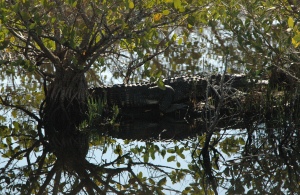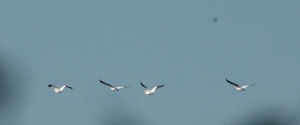Last week we headed down to Titusville to take a beginning bird tour at the Merritt Island National Wildlife Refuge. Back in 1962, NASA acquired 140,000 acres of land to establish the John F Kennedy Space Center. NASA needed about 10,000 acres for their buildings and launch pads. In 1963, the US Fish and Wildlife Service signed an agreement to maintain the remaining acreage as a wildlife refuge.
Today there are more than 500 species of wildlife, including 15 endangered or threatened species, that can be found on the refuge. There are also seven different habitats on the refuge: beaches, coastal dunes, scrub, pine flatwoods, brackish impoundments, hardwood hammocks, and open water estuaries.
There are many activities and classes available at the refuge. Since our knowledge of birds is limited to “look at that big white bird”, or “is that an Eagle or just a big black bird?”, we decided to sign up for the Beginning Bird Tour. It is a 3 hour small shuttle bus tour around the main roads in the refuge, as well at the Black Point Wildlife Drive. The cost of the tour was only $3.00 per person, and children under 16 are free. We highly recommend the tour. If you do not own binoculars or a bird guide, you can check one out from the visitors center for free. Our tour bus driver, Ned, is a retired high school biology teacher, and he did an excellent job both educating and entertaining us.
There are over 900 species of birds in the United States, and over 500 of them can be found in Florida. Ned recommended focusing on the wading birds when starting out, as they are among the easiest group to identify. There are 5 main ways to identify birds: Silhouette (shape and size), Plumage/Colorization, Behavior, Voice, and Habitat Preferences.
Our tour started out on the main roads and we had a few stops near a parking lot, where several birds were busy watching the fisherman. I don’t recall the names of all the birds. After 3 hours, I was on ‘bird overload’!
We then entered the Black Point Wildlife Drive, which is a 7 mile one-way drive through pine flatwoods and very shallow marsh impoundments. The cost to drive on this road is $5.00, but is included in the Bird Tour. The money raised by the refuge is used to make improvements, such as the viewing station shown below. There are several people on the dock, but you can’t see them. They are designed to allow viewing of the birds without scaring them away.
Across the marsh is part of the Kennedy Space Center. The water that you see is only a few inches in-depth, and is brackish (mixture of fresh water and salt water).
And we did see a few alligators hanging around the refuge as well.
One of the wading birds that people come to see at the refuge is the Roseate Spoonbill, which has bright pink colors.
Some of the folks we saw watching the birds had very large (and expensive) zoom lenses on their cameras. They had some excellent photos. I was limited with my little zoom lens, unless we were close to the birds.
We did also see a Great Blue Heron, but he was too far away for my camera.
And another Tricolored Heron, which was probably the fastest bird we saw. He loved to run around the water!
We will definitely return to the refuge in the future. If you are in the area, it is worth a trip!
Quote for the Day: “In order to see birds it is necessary to become part of the silence.” – Robert Lynd
















Happy St. Patty’s Day ! Hope you got to enjoy some green beer. 🙂
Nancy and Dan Tuttle
Thanks Nancy! Happy Spring! No green beer though 😦
#birdnerds!
Easy to get hooked, isn’t it!
It’s still hard to figure out all these birds!
Pingback: Two Birds to Watch While Fishing - the spotted tail